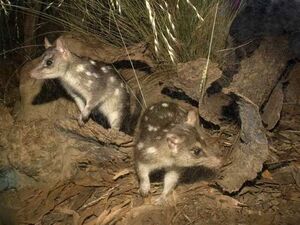
20 years until extinction of Aussie icons
Mon 6 September 2010
20 years until extinction of Aussie icons

A new wave of extinctions is now threatening Australian mammals, this time in northern Australia, according to a group of leading Australian scientists.
The four scientists released a report on Wednesday titled 'Into Oblivion: The disappearing mammals of northern Australia' that for the first time details the extent of the decline.
Dr James Fitzsimons, from The Nature Conservancy, said “Based on current trends, many native mammals will become extinct in northern Australia in the next ten to 20 years.
"We are putting this issue on the national agenda before it is too late because once lost, these animals will disappear from our earth forever.”
He said that most Australians would be unaware that this crisis existed. “The fact is this real risk of extinction threatens even large and iconic national parks in northern Australia such as Kakadu and Litchfield.”
In Kakadu, for example, a scientific monitoring program over the past 15 years shows that the abundance of ten native mammal species has declined significantly, whereas no species increased significantly.
For 136 plots sampled between 2001 and 2004 and again between 2007 and 2009, site-level species richness declined by 65% and the total number of individuals declined by 75%.
The most marked declines were for the Northern Quoll, Fawn Antechinus, Northern Brown Bandicoot, Common Brushtail Possum and Pale Field-rat.
According to Andrew Picone of the Australian Conservation Foundation in Cairns, the main threats to our native animals (and plants) come from a variety of sources.
"Introduced animals such as the Cane Toad, Feral Cats, and also the feral pig has an impact on habitat and preys on ground nesting birds."
Weeds such as Gamba Grass from Africa and Grader Grass from India also have a devastating affect.
"Both of these species of grass burn hotter and can kill woodland trees and out-compete all native species. This destroys the understorey habitat structure and eliminates feed sources for many species including birds and mammals.
"Grazing by cattle, horses, camels and goats causes decline in many species through the removal of understorey, and removing protective cover from predators for many small and medium mammals."
Changed fire regimes are also a critical factor with late dry season fires now common across northern Australia. Research shows that fire has a direct impact on the type and number of species in a typical tropical savannah.
Much of northern Australia is burnt every year. In 2006, over 6 million hectares of Cape York Peninsula was burnt.
“We are not seeking to point the finger of blame at anyone but rather to build a case for action while offering practical solutions that could stem extinction losses.” Dr Fitzsimons said.
He warned that the decline of native mammals in northern Australia may be a signal of looming environmental decay, the first and most obvious indicator of more pervasive ecological ill-health.
“These animals are disappearing because of what we have done to their environment, because of a small range of factors that should be within our understanding and budget to reverse, manipulate and manage.”
The report says that targeted management of all the known threats is urgently required to ensure the survival of mammals.
In the shorter-term, there is also a need to strengthen the safeguards on islands off northern Australia, as a temporary refuge for ‘at risk’ species until a more comprehensive solution can be reached on the mainland.
“Australia has national, state and territory legislation and signed international commitments that oblige us to conserve our biodiversity. The report’s findings suggest we are failing badly.” he said.
Dr Fitzsimons added that the nature-based tourism sector contributes $23 billion to the Australian economy each year.
“The ability to see or learn about Australian wildlife is an essential component of this sector. Losing mammal species comes at a significant risk to Australia’s reputation as a ‘clean, green’ nation that conserves its unique wildlife.”